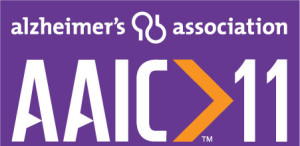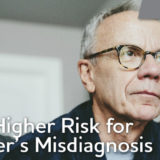Research Advances from the Alzheimer’s Association International Conference 2011
 In July, more than 5,000 scientists from around the world gathered in Paris to report the latest advances in Alzheimer’s research at the Alzheimer’s Association® International Conference 2011 (AAIC 2011). Scientists presented and discussed early detection, medical intervention and global standardization for the health epidemic of the 21st century – Alzheimer’s disease and other dementias. Research highlights from AAIC 2011:
In July, more than 5,000 scientists from around the world gathered in Paris to report the latest advances in Alzheimer’s research at the Alzheimer’s Association® International Conference 2011 (AAIC 2011). Scientists presented and discussed early detection, medical intervention and global standardization for the health epidemic of the 21st century – Alzheimer’s disease and other dementias. Research highlights from AAIC 2011:
The relationship between brain injury and mild cognitive impairment (MCI)
- Older veterans who experienced traumatic brain injury (TBI) showed a more than two-fold increase in the risk of developing dementia. Over a seven-year period, the risk of getting a dementia diagnosis was a little more than 15% in those who had a traumatic brain injury compared with just under 7% in those without TBI.
- In another more preliminary study, researchers compared cognitive test results for a group of former American NFL football players to those of two other groups: (1) 41 similar adults with no cognitive changes and (2) a sample of 81 people diagnosed with mild cognitive impairment (MCI). The researchers found that former football players were at elevated risk for MCI compared with non-athletes. The athletes with MCI had test results similar to the other group with MCI, except the athletes were slightly less impaired and were significantly younger.
The relationship between brain injury and risk of dementia remains unclear, with some studies suggesting an increased risk and others finding no association. It is an important topic that deserves more research attention.
A reduction in modifiable risk factors may prevent millions of Alzheimer’s cases worldwide
Previous research has identified a number of potentially modifiable risk factors for Alzheimer’s. However, it remains unclear whether changing these mostly lifestyle-based risk factors would result in fewer cases of Alzheimer’s. At AAIC 2011, researchers presented a new mathematical model of global Alzheimer’s risk, suggesting that reducing the prevalence of well-known, lifestyle-based, chronic disease risk factors by 25 percent could potentially prevent 3 million cases of Alzheimer’s worldwide, including nearly 500,000 in the U.S.
Scientists used mathematical modeling to calculate the percentage of Alzheimer’s cases that may be attributable to diabetes, mid-life hypertension, mid-life obesity, smoking, depression, low educational attainment and physical inactivity. The researchers caution that these estimates make an assumption that has not yet been proven – that there is a causal relationship between the risk factors examined and Alzheimer’s disease, and that modifying the risk factors may lower Alzheimer’s risk.
A possible new biomarker for Alzheimer’s disease
Researchers explored whether characteristics of blood vessels in the back of the eye might serve as possible biomarkers for Alzheimer’s disease. The researchers found that the width of certain blood vessels in the back of the eye were significantly different for people with Alzheimer’s compared with healthy people, and that this correlated with brain imaging that is indicative of Alzheimer’s. While most Alzheimer’s-related pathology occurs in the brain, the disease has also been reported to create changes in the eye, which is closely connected to the brain and more easily accessible for examination in a doctor’s office. The study is very preliminary, but encouraging.
A relationship between falls and Alzheimer’s?
Scientists reported on a study suggesting that falls are more common among individuals with the earliest brain changes of Alzheimer’s. They measured the rate of falls among seemingly cognitively healthy older adults with and without preclinical Alzheimer’s, as determined by a brain PET scan looking for deposits of a toxic protein called amyloid. Those people with amyloid deposits had twice the risk of falls. These study results suggest that, in some people, changes in gait and balance may appear as early indicators of Alzheimer’s, even before memory changes.
For more in-depth information about these and other studies released at AAIC 2011, visit www.alz.org/aaic.


















I intend to print this info on eyes and send to my optomitrist. Thank you for sharing. My father died with Alz. as did 3 of his 4 siblings and many of his 11 aunts and uncles. His own father was injured in a car wreck and died of the injuries or we suspect he also would have suffered Alz. As you can guess I am concerned and checking for any sign, as are my cousins. Thanks for all your work.